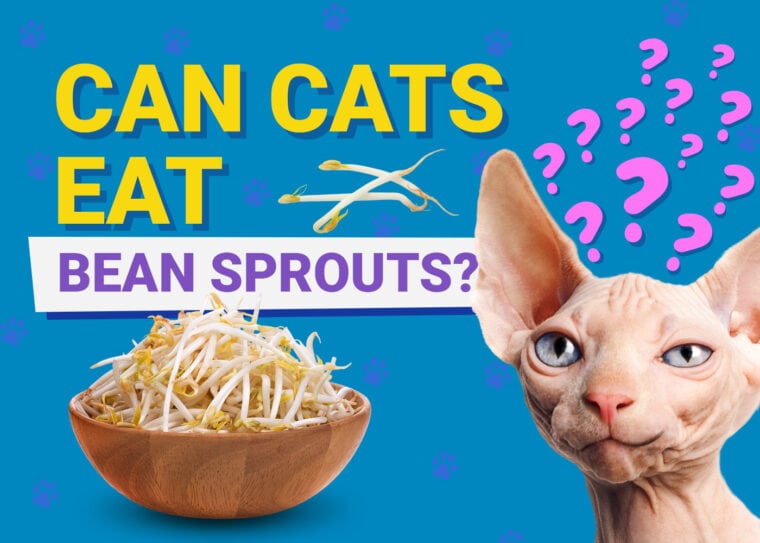
Cats are carnivores, but they can benefit from munching on greens. In the wild, they may chew on grasses and sprouts to supplement their meat-centric diets. The roughage helps clear out their digestive system and can provide vitamins, minerals, antioxidants, and enzymes, among other important nutrients that cats require to thrive. Cats enjoy chewing on all kinds of different greens, which is why many cat owners catch their cats chewing on their houseplants.
Some houseplants are toxic to cats, though, so we have to be careful what our furry friends have access to. It’s best to offer them greens and sprouts that you know will not harm them, so they don’t resort to eating houseplants. Bean sprouts are excellent options for cats, though they should only be offered in moderation, just like any human food.
The Benefits of Feeding Bean Sprouts to Your Cat
Bean sprouts can be nutritious additions to your cat’s diet. You can give your cat a few bean sprouts throughout the week without worrying about resulting health problems. Eating bean sprouts can be beneficial for your cat because they are full of the fiber and nutrients that cats would get in nature by eating animals and wild roughage.
Bean sprouts contain vitamin B, folate, and antioxidants that offer extra protection from disease. Each small bean sprout packs a huge nutrient punch, which means your kitty will reap the nutritional benefits after just a few sprouts. Some cats enjoy the crunchy texture of bean sprouts and can satisfy their chewing craving when they are teething.

The Concerns of Feeding Bean Sprouts to Your Cat
All cats should eat a veterinarian-approved diet and should only have human foods as occasional snacks or treats. If your cat eats too many bean sprouts or any other human food during the day, it could keep them from eating their own food at mealtime. If this happens often, it could lead to nutritional deficiencies. Therefore, bean sprouts and other snacks should make up no more than about 10% of your pet’s overall diet.
Another concern is that bean sprouts grow in moist places, so they can carry bacteria that are harmful to cats. Types of bacteria commonly found on sprouts include Salmonella and E. coli. If the sprouts are not carefully cleaned or boiled before serving, they could make your kitty ill. It is a good idea to find out where your bean sprouts come from if possible, so you can figure out whether any bacteria problems are common in that area.
If they will not be cooked, sprouts should be sprayed with vinegar and thoroughly rinsed in clean water before being served to your cat or you. You can also boil bean sprouts and then rinse them in cool water to ensure that they are safe to consume before serving. Your cat might like eating bean sprouts whole, but younger kitties and kittens might prefer them cut into small pieces.

Sourcing Bean Sprouts for Your Cat (and Yourself!)
You should be able to find bean sprouts in any grocery store, conveniently bagged and ready for preparation at home. However, it can be tough to know where they came from and how long they have been sitting in transport and on the shelf. How can you tell if they have been contaminated with bacteria? Fortunately, bean sprouts are extremely easy to grow in the comfort of your kitchen and take only about a week from start to finish.
You don’t need any pots or soil to grow bean sprouts. They can be grown using nothing more than water, a mason jar, and a little piece of clean window screen. They can also be grown in a simple plastic container that you would normally use to store leftovers. It is important to make sure that the seeds that you use to grow bean sprouts are sourced from a place where you have confidence in their production practices.
Knowing exactly what your feline companion can and cannot eat will help you become the best pet parent. Recognizing that not all cat bowls are equal is also key! The Hepper NomNom Cat Bowl sets itself apart from traditional options by catering to the specific needs of cats. The innovative design offers whisker relief via shallow dishes and promotes digestion with a slight bowl elevation. Find out if the Hepper NomNom is right for your cat by clicking here.
At Pet Keen, we’ve admired Hepper for many years and decided to take a controlling ownership interest so that we could benefit from the outstanding designs of this cool cat company!
Final Thoughts
Cats don’t require the addition of bean sprouts to their diet, but they can benefit from eating them occasionally. Bean sprouts are inexpensive and easy to grow and do not require much storage space. Not all cats like sprouts, so don’t worry if your cat passes on them. As long as your kitty consumes high-quality commercial food designed just for them, they should get all the nutrients that they need to lead a happy and healthy life.
You Might Also Be Interested In:
Featured Image Credit: inewsfoto, Shutterstock









